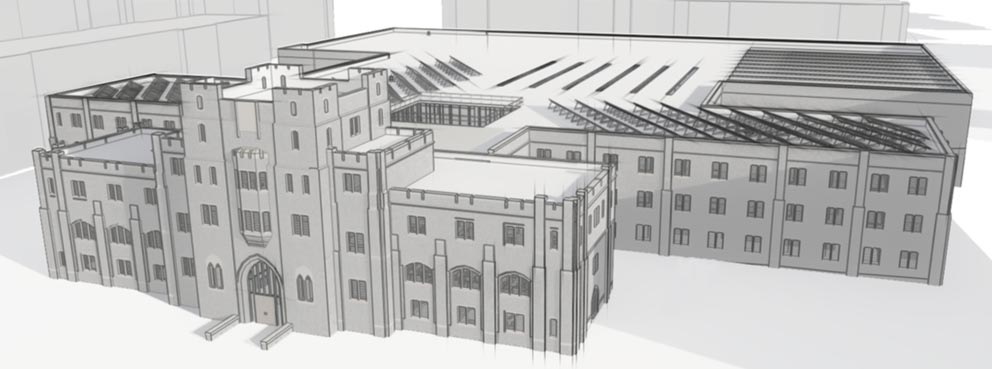
The Penn State AEI Student Design Competition team created renovation plans for the historic War Memorial Hall, a recreational sports facility on the campus of Virginia Polytechnic Institute and State University. IMAGE: DEPARTMENT OF ARCHITECTURAL ENGINEERING
Gift to support architectural engineering's winning student design team
6/30/2020
By Mariah Chuprinski
UNIVERSITY PARK, Pa. — For the last decade, Penn State’s student design team has performed exceptionally well at the Architectural Engineering Institute (AEI) International Student Design Competition. A new $50,000 gift will help the success of future teams through additions like new technology and skill-building opportunities.
The fund was created by Bob Grottenthaler, a 1980 architectural engineering alumnus and semi-retired senior vice president at Barton Malow, and his wife, Cheri Grottenthaler, a graduate of Arizona State University and a retired director of respiratory therapy at Mayo Clinic Hospital, and most recently, Johns Hopkins Bayview Medical Center.
Each year, fifth-year students from Penn State’s Department of Architectural Engineering (AE) complete a yearlong, eight-credit capstone thesis course, in which they demonstrate their engineering design skills through a real-life design project of their choice. Students choose between an individual thesis project or a 10-person group project. The 10-person teams compete against one another in front of AE faculty and industry members, who select one team to represent Penn State AE formally in the AEI competition.
“The technology and experiences that are afforded by this gift will provide mechanisms to explore and refine the course to set up students for early leadership success in industry,” said Ryan Solnosky, associate teaching professor of architectural engineering and coordinating adviser of the team-oriented capstone.
In establishing the gift, titled The Bob and Cheri Grottenthaler AEI Teams Excellence Fund, the donors were inspired by years of involvement in the competition and were convinced of the value of the capstone experience for graduating seniors entering the workforce.
“It always gave me great pride seeing the Penn State team compete — and win — against teams from around the country, and now, internationally,” said Bob Grottenthaler. “I wanted to contribute in some way so that students have what they need to put their best effort forward and continue to be recognized as the best team in the country.”
Over a span of five years from 2013 through 2018, Grottenthaler spent time as a juror of the competition, as a member of its board of governors and as its president.
“In the working world, engineers do not conduct individual projects, but rather work on interdisciplinary teams,” Grottenthaler said. “When students form and work on teams like in the AEI competition, they develop collaborative skills which far outweigh an individual project approach.”
The gift will be distributed over five years and will fund recognition awards for team members, opportunities to develop skills for multi-disciplinary teams, field trips, guest lectures and opportunities to engage with industry members. It also will fund new technology purchases that will enhance students’ designs and the overall learning experience.
This year, at the virtual competition, Penn State’s design team received one award in each category, including first place finishes in structural system design and lighting/electrical system design; second place finishes in building integration, construction and mechanical engineering; and an innovation award for a wellness hub challenge. The team created renovation plans for the historic War Memorial Hall, a recreational sports facility on the campus of Virginia Polytechnic Institute and State University.
Last year, Penn State earned first place in all five core categories, including the top honor for building integration, for their design of a historic musical arts center.
Samuel Dzwill, a 2020 architectural engineering graduate and new field engineer for Turner Construction, said he chose to participate in the group project because it was analogous to working in industry, where members from each discipline work together to solve complex problems in inventive ways.
“The team thesis was a perfect cap to my degree,” Dzwill said. “While I picked up parts and pieces through the first four years of my education, the AEI competition really put all of the parts together and allowed me to apply and test all that I had learned toward a common goal.”
Sez Atamturktur, Harry and Arlene Schell Professor and head of the Department of Architectural Engineering, said Penn State AE’s systems-focused curriculum is one reason why the team consistently performs well.
“Working in teams and analyzing and designing interdependent systems-of-systems is at the core of our educational philosophy,” she said. “A heartfelt thanks to Bob and Cheri Grottenthaler for recognizing the tremendous effort by our students and helping us provide world-class educational opportunities for them.”
This gift will advance “A Greater Penn State for 21st Century Excellence,” a focused campaign that seeks to elevate Penn State’s position as a leading public university in a world defined by rapid change and global connections. With the support of alumni and friends, “A Greater Penn State” seeks to fulfill the three key imperatives of a 21st-century public university: keeping the doors to higher education open to hardworking students regardless of financial well-being; creating transformative experiences that go beyond the classroom; and impacting the world by fueling discovery, innovation and entrepreneurship. To learn more about “A Greater Penn State for 21st Century Excellence,” visit greaterpennstate.psu.edu.




